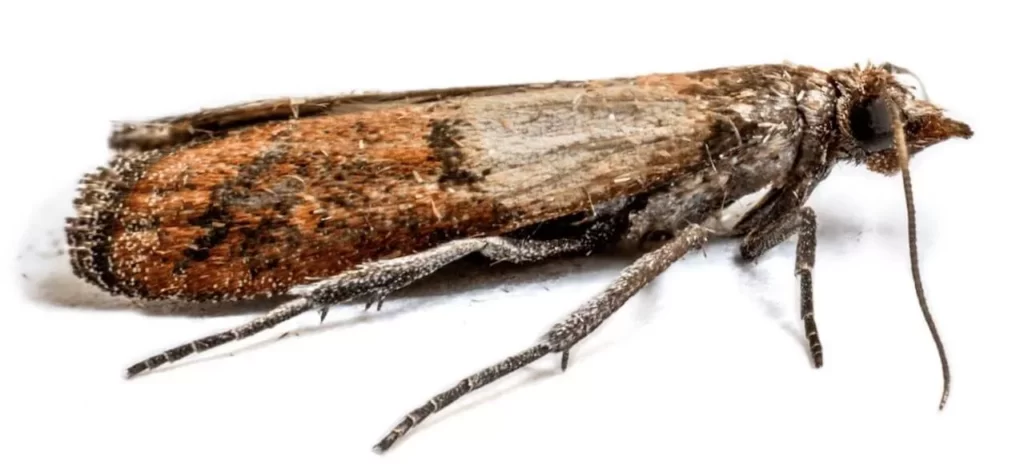Indian Meal Moth

Ask About Our
100% Eco-Friendly
Options

Moth Control Services In Central Wisconsin

What are Moths?
The Indian meal moth is a handsome moth with a wing expanse of nearly three-quarters of an inch. It is easy to distinguish from other grain pests by the peculiar markings of the forewings; they are reddish brown with a copper luster on the outer two-thirds, but whitish gray on the inner or body ends. The hind wings lack distinctive markings and are more or less uniformly gray. Adults can be seen resting on the grain surface or grain bin walls. The adults fly at night and are attracted to lights.
The eggs of the Indian meal moth are whitish, ovate, and very small. Because of their small size, they are difficult to see without the aid of a microscope. Eggs are deposited on the grain surface singularly or in groups of twelve to thirty.
Newly hatched larvae are very small and difficult to see. Larger larvae are usually yellowish, greenish, or pinkish. Fully grown larvae are one-half to five-eighths of an inch in length with a brownish head capsule. Larvae have three sets of legs near the head (thoracic legs) and five sets of prolegs on the abdomen. Larvae of the meal moth spin a web as they become fully grown and leave behind silken threads wherever they crawl. The webbing is often sufficiently abundant to attract attention. Loosely clinging webbing on the grain is characteristic of this pest.
Indian meal moth life cycle
As long as the temperature within a grain bin or building where grain is stored remains above 50° F, the Indian meal moth can survive and reproduce. A typical life cycle (egg to adult) is completed in fourth to fifty-five days. A potential for seven to nine generations per year exists; however, because of cool temperatures during the winter months fewer generations are usually completed. Under optimal conditions, the entire life cycle can be completed in approximately twenty-eight days.
A mature female lays 100 to 300 eggs on food material, either singularly or in groups of twelve to thirty. Larvae begin to hatch in two to fourteen days, depending on environmental conditions. Newly hatched larvae feed on fine materials within the grain and are small enough to pass through a sixty mesh screen. For this reason, it is difficult to exclude larvae from most packaged foods and grains.
However, larvae cannot chew through packages, so they must enter through a hole or at the seam. The larval stage lasts from two weeks to one year and is responsible for grain losses. In grain, larval feeding is usually restricted to the top one to two inches. Large larvae feed on the grain germ. When mature, larvae spin a silken cocoon and transform into light-brown pupae. The cocoons and pupae can be seen on the grain surface and walls of grain bins. Adults emerge in four to thirty days, mate, and females lay the next generation of eggs. Adults live from five to twenty-five days.
Frequently Asked Questions
Signs of a moth infestation may include seeing moths flying in or around your home, finding moth larvae or pupae in clothing or food, and experiencing a musty or stale odor.
Moths can enter your home through open windows or doors, as well as on items such as clothing or food.
Effective moth treatments may include using insecticide sprays or traps, as well as removing any infested materials from your home. It’s best to consult with a pest control professional for the most effective treatment plan.
To prevent moths from entering your home, keep food in sealed containers, store clothing in sealed plastic bags, and vacuum and clean your home regularly.
Damage caused by Indian meal moths
Finding webbing or a large number of caterpillars or worm-like larvae (immature insect stage) crawling about in a box or container of cereal or spices is often the first indication of an infestation. Also, moths flying around the kitchen or an enclosed area such as a garage is a sign that you should inspect grain products, cereals, spices, dry pet food, and birdseed.
Discard infested products. A quick check of other nearby containers should be made. If no additional insects are seen, it may be assumed that the infestation was limited to that area.
However, if the first indication is the occurrence of insects crawling or flying about outside of a package, then a more thorough search for the source of the pests is necessary.
All containers of dry packaged foods such as nutmeats, dried fruits, flour, meal, pasta, breakfast cereals, or spices (especially red pepper, paprika, and chili powder) must be examined carefully. They sometimes will infest dried flowers. Adults and small worm-like larvae may be found.
Sawdust-like droppings, called frass, may also be found.
Unopened containers must also be checked to be sure that pests have not gained entry.
How to get rid of Indian meal moth
Prevention is the best control for pantry pests.
When purchasing bulk grains, dried fruit, flour, etc., inspect it carefully when loading it into bags for weighing.
Inspect products again when you get them home and put them into storage containers. Keep food in glass jars, plastic containers, or metal canisters. Glass jars that pressure seal with rubber gaskets are the best. Make sure they have tight-fitting lids. Many of the pantry pests are very small and can crawl under loose-fitting lids.
Do not store products in plastic bags, or cardboard boxes as the insects can chew through them.
Try to store foods in a cool dry place. Most of the stored product pests multiply faster at higher humidity. Many products can be kept in the freezer to prevent infestation, especially products that are not used right away. Nuts, flours, meals, and dried chili peppers can all be frozen.
Infested foods should be thrown away and the shelves cleaned thoroughly to eliminate food material and insect eggs or larvae which might be in cracks or corners.
Vacuum the shelves and then wash the cupboards with warm soapy water. Do not spray any food storage areas with insecticides. Clean up any food spills promptly.


 Service Request
Service Request